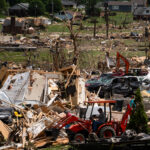Insurance companies must pay up to the policy limits for cleanup of the Stringfellow Acid Pits in Riverside County, the California Supreme Court ruled.
The 17-acre industrial waste dump 50 miles east of Los Angeles near Glen Avon was operated by the state from 1956 to 1972 and contaminants fouled groundwater supplies. The site, which was once a quarry, later became a federal Superfund site.
The state high court’s unanimous decision on Thursday, which ends a decades-long dispute, means insurance companies may owe California up to $60 million, including interest, said Roger W. Simpson, who represented California in the case.
The state has already collected $120 million from other insurance companies.
The California Supreme Court, basing its decision on insurance policy language, ruled that consecutive policies require each insurer to pay up to their policy limits for waste site damages, the Los Angeles Times reported. Insurers wanted to restrict liability to a share of the damage that occurred during the time each policy was in effect.
California purchased multiple policies and paid multiple premiums and the court ruled the state should be able to collect up to the policy limit from each insurance company.
Writing for the court, Justice Ming W. Chin said it was impossible to prove the precise amount of damage during a specific policy period.
“The fact that all policies were covering the risk at some point during the property loss is enough to trigger the insurers’ indemnity obligation,” Chin wrote.
Attorney Rene L. Siemens, who represents policyholders, said the ruling could cost the insurance industry billions of dollars in future cases.
Insurance companies lawyer Philip Matthews called the decision disappointing, but he disagreed with Siemens’ assessment.
Most insurance policies written since 1985 would not be affected by the decision, Matthews said.
The Stringfellow site was shut down in 1972 when it became clear underground water supplies were being polluted. It made national headlines in the 1980s because it was considered California’s most-polluted toxic dump and it became one of the nation’s first U.S. Environmental Protection Agency Superfund sites.
Was this article valuable?
Here are more articles you may enjoy.

 Will Workers’ Comp Benefit from ‘Most-Favored-Nation’ Drug Pricing?
Will Workers’ Comp Benefit from ‘Most-Favored-Nation’ Drug Pricing?  Two Chevron Workers Die of Injuries From Angola Platform Fire
Two Chevron Workers Die of Injuries From Angola Platform Fire  Trump Administration Targets Resiliency Funds to Shrink FEMA’s Role
Trump Administration Targets Resiliency Funds to Shrink FEMA’s Role  Plane Crashes into San Diego Neighborhood, Setting Homes And Vehicles on Fire
Plane Crashes into San Diego Neighborhood, Setting Homes And Vehicles on Fire 